The US will see the sharpest decline, dropping 26% to $79 billion.
James D. Crandell and James C. West, Barclays Capital
Barclays Capital’s Oil Service and Drilling section issued its semi-annual spending survey on Dec. 19, 2008. The 24-page report includes responses from 357 companies analyzing spending for 2008 and planned expenditures for 2009. The report focuses on the US, Canada and regions Outside North America (ONA). The data includes 32 tables and figures with Barclay Capital’s comments, survey findings, the survey process and results, as well as company observations.
“The Original E&P Spending Survey” attempts to include every meaningful spender on exploration and production throughout the world, which encompasses integrated oil companies, independents and national oil companies. In addition, a number of Middle Eastern and African state-owned oil companies are included for the first time.
The survey forecasts that 2009’s global exploration and production expenditures will contract 12%. Budgets are being cut in response to the significant decline in commodity prices, constrained cash flow and tight credit markets.
The sharpest spending decline is expected to be in the US, where 2009 E&P expenditures are indicated to drop 26%. Canadian budgets are slated to drop 23%.
Given the longer-term nature of international projects and the dominance of the majors and national oil companies internationally, E&P capex budgets outside North America are showing more moderate declines—down 6% in 2009.
GLOBAL CAPEX
After six years of growth, worldwide E&P Capex budgets will contract by about 12% in 2009 to $400 billion from $454 billion in 2008, according to 357 companies surveyed. It is important to note that given the fluid economic conditions and volatility in oil and gas pricing, operators are continuing to revise budgets and the spending cuts could be understated.
The dramatic turnaround in spending is a result of the sharp decline in commodity prices and tight credit markets. North American independents are highly sensitive to gas prices and cash flow, and adjust budgets quickly as conditions warrant. Many independent E&P firms were outspending cash flow using debt, but credit market issues will likely limit this in 2009.
International expenditures are expected to hold up better than those in North America, but will still decline. After nine years of growth, at double-digit rates the last three years, 2009 spending is expected to decline by 6% to $300 billion from $319 billion in 2008, according to the 100 ONA companies surveyed.
BUDGET FORECAST
In an abrupt reversal of planned 2009 Capex in the US, spending budgets are indicated to decline by 26% to $79 billion from $106 billion in 2008. This would end a four-year upturn. While the largest companies typically respond less quickly to changing industry conditions, given the severe nature of this correction, companies of all sizes are reacting with significant budget reductions.
Of the 245 companies surveyed for spending in the US, 153 (62%) plan to cut spending by more than 10% in 2009. Just 32 US companies surveyed (13%) plan to increase spending by 10% or more next year, and an additional 60 (25%) companies anticipate that 2009 spending will be flat.
The larger companies that we estimate will have the greatest budget cuts in 2009 vs. 2008 are Chesapeake Energy (down 51%), Devon Energy (down 44%), EOG Resources (down 34%), Sandridge Energy (down 78%), Hess Corp. (down 62%), Anadarko Petroleum (down 32%) and ConocoPhillips (down 23%)-all of which have budget cuts of at least $1 billion. No companies are making sizable additions to their budgets.
CANADIAN EXPENDITURES
For the past two years, Canadian capital spending has lagged that in the US and internationally. In 2009, Capex is slated to be down by an amount similar to that in the US. Capex budgets are forecast to fall 23% in 2009 to $22 billion from $29 billion in 2008, by the 85 companies surveyed that have Canadian operations. Similar to trends in the US, the reductions are broad-based across all company budget sizes.
| 2008 - 2009 “supermajor” international budgets, $ million |
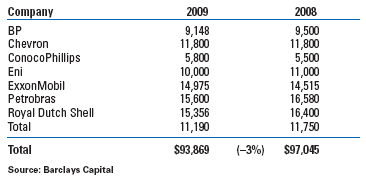 |
|
Among the larger companies that will have the greatest budget cuts are Husky Energy (down 47%), Devon Energy (down 71%), Talisman Energy (down 47%), EnCana (down 16%), Canadian Natural Resources (down 23%), ConocoPhillips (down 14%), Penn West Petroleum (down 20%), EOG Resources (down 50%), Nexen (down 47%), Royal Dutch Shell (down 7%), Imperial Oil (down 13%), Murphy Oil (down 25%), Crew Energy (down 56%) and Apache (down 13%).
INTERNATIONAL SPENDING
While holding up better than North American spending budgets, international Capex is forecast to decline by 6% to $300 billion from $319 billion, based on 100 companies in the survey with international operations. Budget trends are mixed internationally-while overall spending is down, several companies plan to increase E&P expenditures in 2009.
| 2008 - 2009 selected North American independents’ international budgets, $ million |
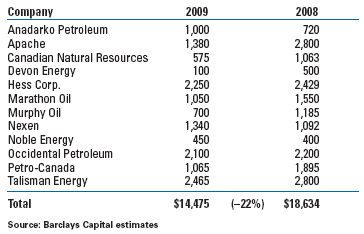 |
|
Supermajors. The supermajors have flattened their international E&P spending, with the big eight estimated in the aggregate to have a 3% decline. BP is reducing spending by 4% with Royal Dutch Shell and Total anticipated expenditure cuts of 6% and 5%, respectively. Chevron is planning to maintain its 2008 budget into 2009. ConocoPhillips and ExxonMobil will likely boost expenditures by 5% and 3%, respectively.
Russia. After being a leader in spending growth over the past several years, Russian companies are now showing some of the largest E&P spending cuts for 2009. Lukoil is expected to reduce its 2009 Capex by 50% with Surgutneftegaz, Gazprom Neft, Rosneft and TNK reducing budgets by between 20% and 26%. Only Gazprom is expected to spend more in 2009 compared to 2008-up a modest 2%. Pressure on cash flows, financial market issues and corporate disappointment over tax reform are all leading to the turnaround in Russia.
Latin America. Petrotrin (up 27%) and Pemex (up a modest 5%) expect to boost 2009 E&P expenditures. For Pemex, spending in the Chicontepec and Cantarell areas is partially offset by a slowdown in Burgos and southern Mexico. Budget declines are forecast for Pan American Energy (down 5%), PDVSA (down 15%) and Petrobras (down 6%). Latin America on balance is forecast to be modestly lower.
Middle East/Africa. The average spending by the nine companies surveyed from the Middle East/Africa region will decline 2% in 2009. Increases for Adnoc (up 22%), Kuwait Oil Co. (up 15%), National Oil Corp. (up 20%), Sonangol (up 3%) and Sonatrach (up 10%) will be offset by declines at Saudi Aramco (down 15%), NNPC (down 13%) and Petroleum Development of Oman (down 5%).
2008 - 2009 US E&P expenditures, $ million
Click table to enlarge |
.png) |
|
2008 - 2009 US E&P expenditures, $ million cont.
Click table to enlarge |
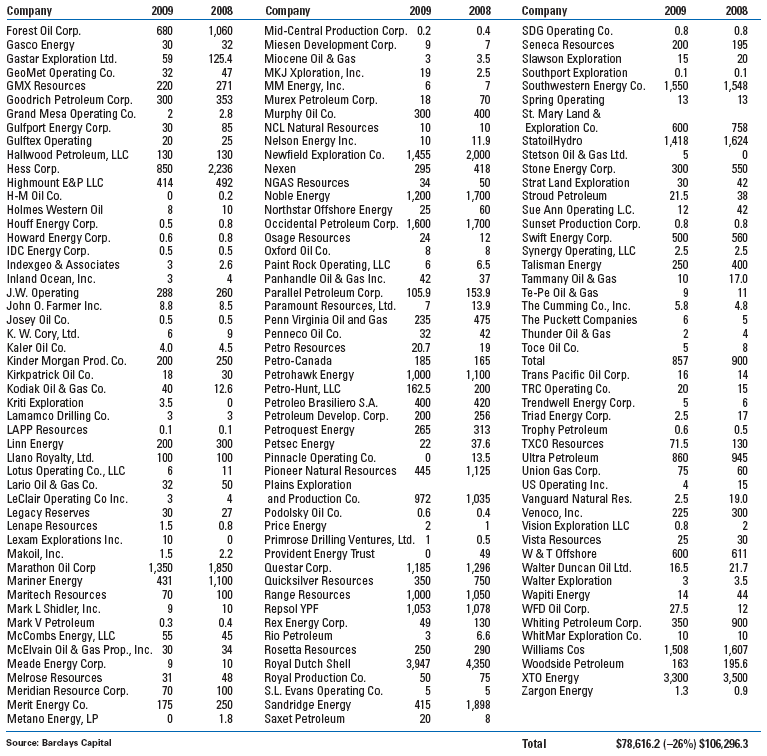 |
|
Europe. European-based companies are taking a deep slice out of their 2009 E&P expenditures, with the top six companies in aggregate showing declines of 11%. BG Group is maintaining its budget at the 2008 level, but Eni, OMV, Repsol-YPF, StatoilHydro and Wintershall Holding are all showing declines for 2009.
Asia. Trends for state-owned and international oil companies based in Asia are also mixed. Companies such as CNOOC (down 13%), Pertamina (down 11%), PTT E&P (down 16%) and Reliance Industries (down 15%) are showing budget cuts, while others are forecasting gains-Inpex (up 13%), ONGC (up 7%) and Petronas (up 10%).
North American independents. Independents based in North America invest the bulk of their capital in their home countries, but in recent years, these companies have shifted funds to international operations. These companies are showing mixed plans for international investments in 2009, with some companies showing growth, but others showing big cuts leading to an overall 22% decline in spending.
SURVEY FINDINGS
Spending in 2008 was well above original budgets. The rise in oil and gas prices through mid-2008 led to an increase of 22% in global E&P capital expenditures for 2008, vs. expected increases of 20% in the 2008 midyear survey and 11% at the beginning of the year. Lower oil prices are expected to continue in 2009 with companies basing their 2009 E&P budgets on a crude oil price of about $58/bbl (WTI). This average oil price assumption is significantly below the $85/bbl indicated in our midyear survey and the $68/bbl in last year’s survey. The most frequently cited price that would result in a cutting of E&P budgets is $50/bbl for oil and $5/Mcf for natural gas (Henry Hub).
A large majority of companies expect to spend within their cash flow in 2009. Of the companies we surveyed, 74% expect 2009 E&P spending to be equal to or less than total cash flow. Only 26% of operators expect 2009 spending to exceed cash flow, compared with 43% in the prior year.
Credit market conditions have affected 30% of companies’ Capex plans this year, with 42% of respondents anticipating that credit market conditions may affect spending during 2009.
2008 - 2009 Canadian E&P expenditures, $ million
Click table to enlarge |
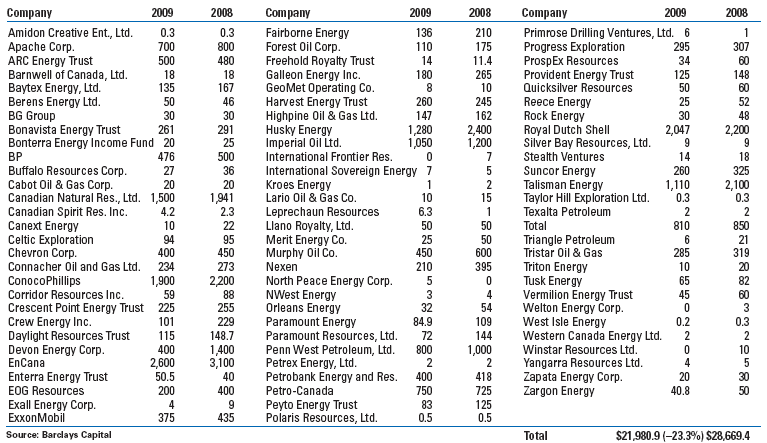 |
|
Although natural gas prices continued to be the leading driver of E&P budget decisions for 2009 spending, the percentage of respondents that listed oil prices among key determinants increased by 10% compared with the prior year survey, to 49%. The average natural gas price used with 2009 E&P budgets is $6.35/Mcf. This estimate represents a modest decrease (down 6%) in price expectations compared with one year ago and a significant decline from expectations at midyear (down 21%).
Cash flow also ranked highly among respondents (48%), while the importance of prospect availability of those surveyed fell dramatically-to 23% from 45% last year.
Although 53% of those surveyed (up from 49% in the prior year) characterized the economics of drilling in the US in 2009 as good, 8% of operators viewed the economics of drilling in the country as poor (up from 4% in the prior year). Internationally, the percentage of operators responding that drilling economics were either “good” or “excellent” for 2009 declined to 55% from 65% in 2008.
The most important technology for 2009 was identified as fracturing/stimulation by more operators than any other technology, overtaking 3D/4D seismic, which slipped to third. Horizontal drilling (second) was also frequently mentioned, as were directional drilling, reservoir recovery optimization and drill bit technology.
SURVEY METHODOLOGY
The authors surveyed 357 companies on their worldwide E&P expenditure plans for 2008 and 2009, asking detailed questions about the composition of budgets and strategic shifts within these budgets. Surveys were faxed and emailed to all participants, and followed up with numerous telephone calls.
Given the significant declines in oil and natural gas prices in November and December, the authors attempted to get back to as many survey participants as possible in the week before publication, for both additional spending reductions and revisions in oil and natural gas prices used to put together budgets. All E&P expenditures, however, are estimates, and incorporate a variety of sources.
RESPONSES
As the authors have done since 1982, we asked the companies in our survey a number of questions about their budgets. The results of these questions follow:
• Spending in 2008 rose by a greater amount vs. the prior year, reflecting strong increases in North America. Global E&P expenditures are forecast to increase 22% in 2008 vs. the 20% increase that was expected in our midyear 2008 survey.
In the US, companies now expect overall spending in 2008 to have been about 25% higher vs. 2007 levels, compared with an expected increase of 15% in our midyear survey and 3.5% in our December 2007 survey. Canadian spending continued to increase, and is now expected to be 16% higher, compared with an 11% increase expected in our midyear 2008 survey.
The rate of increase in international E&P expenditures remained relatively steady during 2008, up 21% from 2007 vs. expectations of up 22% in our midyear 2008 survey.
• During the first half of 2008, many companies overspent their original 2008 budgets. In the US, about 61% of companies surveyed spent more than they had expected one year ago, while just 25% underspent their budgets and 14% spent about the same as they had expected. In Canada, 68% overspent their original 2008 budgets.
2008 - 09 International (outside North America) E&P expenditures, $ million
Click table to enlarge |
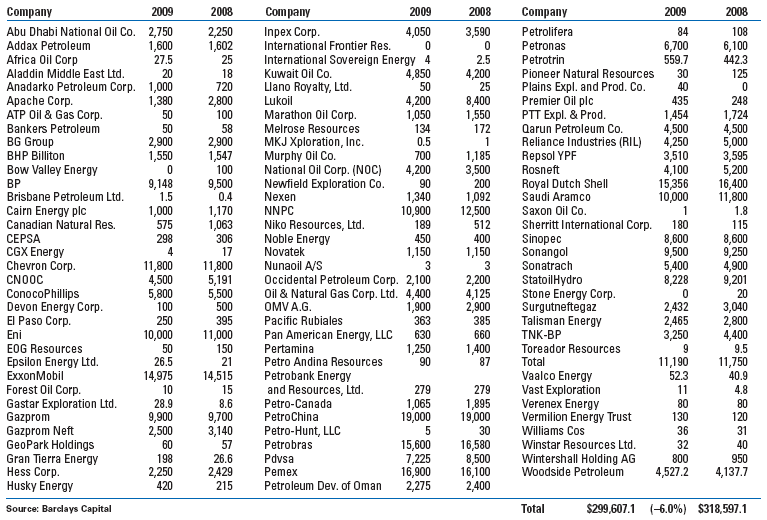 |
|
On a worldwide basis, companies on average overspent their original 2008 budgets by about 14% in dollar terms. Overspending was most pronounced in the US and Canada, with budgets being overspent by 24% and 27%, respectively.
• The large majority of companies surveyed (74%) expect to spend within their cash flow during 2009, with 47% projecting expenditures to be less than cash flow and 27% expecting expenditures to equal cash flow.
• Some 30% of companies indicated that challenging credit market conditions affected capital expenditure plans in 2008. An increased percentage (42%) saw credit market conditions affecting spending in 2009.
• For the fourth year in a row, natural gas prices were highlighted as the most important determinant of E&P spending in the coming year. This is partly due to the large number of North American-based independents in our survey.
• During 2008, 30% of the companies surveyed that spent money offshore spent an increased percentage of their budget there, while 20% spent a smaller portion of their budget offshore. However, for 2009, just 20% expect an increasing proportion of the budget to be offshore, while 35% expect that to decline.
• More operators continue to prefer the economics of drilling over purchasing. The percentage of respondents reporting more favorable drilling economics was 72% in the US (down from 83% in 2008), 52% in Canada (vs. 66% in 2008), and 67% internationally (down from 86% in 2008). Operators were evenly split on whether they were actively seeking to purchase reserves, with 49% responding “yes” and 51% responding “no.”
• International exploration economics continue to be viewed best; however, operators have muted their enthusiasm. For 2009, 55% of companies believe conditions are “excellent” or “good” internationally, down from 66% in our prior survey. In the US, a slight majority (53%) of surveyed companies believe conditions are “good,” while the percentage of “poor” responses was up. Views on Canadian exploration economics remained relatively unchanged, with about half of operators (51%) believing the economics were “fair.”
Editor’s note: It is not statistically accurate to compare total estimates with those from prior years because the companies surveyed vary from year to year. 
|



.png)




